
Travel Guide
Introduction
Harajuku is the common name given to a geographic area spreading from Harajuku Station to Omotesando.
It is the center of Japan's most extreme teenage cultures and fashion styles. The focal point of Harajuku's teenage culture is Takeshita Dori (Takeshita Street) and its side streets, which are lined by many trendy shops, fashion boutiques, used clothes stores, crepe stands and fast food outlets geared towards the fashion and trend conscious teens. Especially Takeshita Dori, shops sell a most extraordinary blend of goods reflecting the Japanese notions of “cute”, “cool and American” and “rebellious and British”.
From Harajuku station to Meiji Dori, about hundreds of meters long street, Takeshita Dori, is the center of Harajuku. Takeshita Dori is easy to find. Take Takeshita Exit of Harajuku station, a gate with the words "Takeshita Street" will appear in front of you. Looking down the street, you can see many people walking on the 360 meter long street. This street is Takeshita Dori. There are many small shops on both sides of the street, which are rich in goods and sold at a resonable price.
After the GAP at the intersection of Omotesando Dori and Meiji Dori was demolished, Toku Real Estate took over and built new commercial facilities. Now it is officially named "Toku Plaza Omotesando Harajuku" and opened on April 18, 2012. Toku Plaza Omotesando Harajuku provides world famous brands. The most special is that the roof top takes the forest as the concept to create a fresh visual scene of the air garden.
Led by fashion, music and art, Takeshita Dori is home to many street cultures. As one of the few bustling streets in Tokyo, this place flourishes and gathers many tourists every day. In addition to Takeshita Dori, do you know an interesting alley named "Brahms path" which is entered from Takeshita Dori? Although adjacent, Takeshita Dori and Brahms path have totally different characteristics. In contrast to the magnificent atmosphere of Takeshita Dori, Brahms path stands leisurely in the dark alleys. Antique style street lights, will lead pedestrians into the silent world. More than 40 years ago, as a compound facility of art and culture, a foreign shop was born in this place. Later, in the surrounding areas, European style fashion shops and stone making coffee shops were constantly built, and the Brahms path, as the fashion place of the original residence, grew up fast. Although it is a narrow path, it is a scenic spot. Takeshita Dori as a young people's street, it is full of vitality, and Brahms path full of adult style. If you have a chance to come to Harajuku, you must go to these two streets with characteristics.
The next recommended shopping spot of Harajuku is "Cat Street". Cat Street is a shopping street that can be accessed from the streets of Omotesando. Cat Street is one of Ura Harajuku. There are many recommended high-end brands and personalized old clothes shops. Many Japanese brands have flagship stores here, where can enjoy delicious food while shopping and walking in comfortable coffee shops and restaurants. Cat Street is recommended to tourists who want to enjoy the slow shoping in Harajuku.
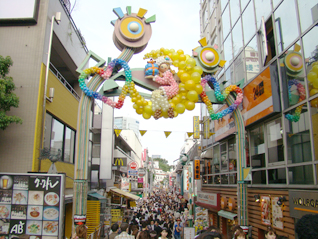
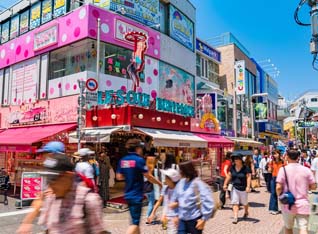
The neighborhood also attracts many larger international chain stores with high-end luxury merchandisers extensively represented along Omotesando. The stylish Omotesando Hills complex was opened in 2006 and targets fashion conscious urbanites in their 30s and 40s.
In order to experience the teenage culture at its most extreme, visit Harajuku on a Sunday, when many young people gather around Harajuku Station and engage in cosplay ("costume play"), dressed up in excentric costumes to resemble anime characters, punk musicians, etc.
Harajuku is not only about teenage culture and shopping. Meiji Jingu, one of Tokyo's major shrines, is located just west of the railway tracks in a large green oasis shared with the spacious Yoyogi Park. For more Sunday street entertainment, you can head up to Yoyogi Park.
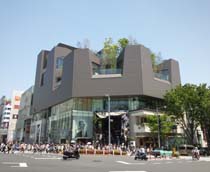
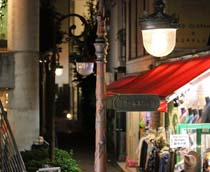
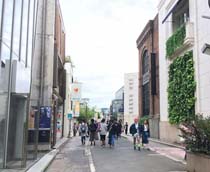
History
Pre Edo period
In the pre Edo period, the area that came to be known as Harajuku was a small post town on the Kamakura Highway. It was said that in the Gosannen War, Minamoto no Yoshiie mustered his soldiers in this area and the hill here is called Seizoroi-saka (current Jingūmae 2 chome). It is said that as the Igagoe reward for delivering Ieyasu Tokugawa safely from Sakai to Mikawa in the 1582 Honno-ji Incident, Onden-mura (隠田村) together with Harajuku-mura (Harajuku村) were given to the Iga ninja in 1590.
In the Edo period, an Iga clan residence was put in Harajuku to defend Edo, due to its strategic location south of the Koshu Road. Other than the mansion of the Hiroshima Domain feudal lord Asano (current Jingūmae 4 and 5 chome), there were many mansions of shogunate retainers. The livelihood of the farmers consisted mainly of rice cleaning and flour milling with the watermill at the Shibuya River. However, due to the poor quality of the land, production never succeeded and the villages never prospered. It is said that local farmers often performed rain-making invocations at local shrines in an attempt to improve their fortunes. There are also the tales Oyama-Afuri Shrine of Tanzawa and Worshipped on the day trip to Mt Haruna remaining.
Meiji Restoration to the end of the Second World War (1868 - 1945)
At the start of the Meiji period in 1868, the land around Harajuku Village was owned by the shogunate. In November of the same year, the towns and villages of Shibuya Ward, including Harajuku Village, were placed under the jurisdiction of the Tokyo Prefecture.
In 1906, Harajuku Station was opened as a part of the expansion of the Yamanote Line. In 1919, with the establishment of Meiji Shrine, Omotesando was widened and reordered as a formal approach route.
In 1940, the Togo Shrine was built and consecrated in honor of Imperial Japanese Navy Marshal-Admiral Marquis Togo Heihachiro.
In the final period of the Pacific War in 1945, much of the area was burned to the ground during the Great Tokyo Air Raid.
1945 to 1970
During the post war occupation, military barracks known as "Washington Heights" were constructed on land that is now occupied by Yoyogi Park and the Yoyogi National Gymnasium. Shops that appealed to the US soldiers and their families such as Kiddyland, Oriental Bazaar, and the Fuji Tori opened along Omotesando during this period.
In 1964, swimming, diving and basketball events for the Tokyo Olympics were held in the neighbouring Yoyogi National Gymnasium.
In 1965, the name of the area in the Japanese address system was officially changed to from Harajuku to Jingumae. The name Harajuku has persisted due the earlier naming of the nearby JR East Harajuku Station. Prior to 1965, Onden, referred to the low-lying area close to Meiji Street and the Shibuya River while "Harajuku" referred to the northern end of Omotesando, the plateau around Aoyama, currently known as Jingu-mae block 2, a large area of Jingu-mae block 3, and the plateau extending behind Togo Shrine in Jingu-mae block 1. The area from Harajuku station to the area surrounding Takeshita Street was called "Takeshita-cho".
The 1970s and 1980s
Coming into the 1970s, fashion-obsessed youth culture experienced a transition from Shinjuku to Harajuku, then to Shibuya. Palais France, a building that sold fashion clothing and accessories, furniture, and other goods, was constructed on Meiji Street near the exit of Takeshita Street. In 1978, the fashion building Laforet Harajuku was opened, and Harajuku came to be widely known as the centre for fashion retail.
In the 1980s, Takeshita Street became popular thanks to the popularity of the Takenoko Group.
From 1977, a Sundays only pedestrian precinct was established by closing local roads. This produced a surge in people gathering close to entrances of Yoyogi Park to watch Rock 'n' Rollers and start-up bands performing impromptu open air gigs. In the peak period, crowds of up to 10,000 people would gather. In 1996, the Sundays only pedestrian paradise was abolished.
1990s to present
In the 1990s and 2000s, with the rise of fast fashion, there was an influx of international fashion brand flagship store openings including Gap Inc., Forever 21, Uniqlo, Topshop and H&M. At the same time, new independent fashion trend shops spread into the previously residential areas of Jingumae 3 and 4 chome, with this area becoming known as Ura-Harajuku. (The "Harajuku Backstreets").
In 2006, Omotesando Hills opened replacing the former Dojunkai apartments on Omotesando.
In 2008, the Tokyo Metro Fukutoshin Line opened providing an alternative metro access linking Harajuku to Shibuya and Ikebukuro.
Travel Advice
Harajuku Girls
Harajuku Girls - Harajuku fashion is a hot Tokyo fashion style of Harajuku girls with many pictures and shopping guide. Harajuku Girls is a term to describe women and teenaged girls in Harajuku who wear a style of clothing that originated in the street culture of major cities in Japan, i.e. Tokyo and Osaka. The "Harajuku style," named for the Harajuku district of Tokyo, combines a wide range of diverse influences, and is also known as "Fruits Fashion" by followers of Fruits Magazine. The terms "Harajuku Girls" and "Fruits" are not used by the Japanese to describe themselves.
There are many fashion styles, and many different groups who spend time in this area. You may see people dressed in the following styles: Gothic Lolita, Decora, Kogal, Ganguro, Wamono, Second-Hand Fashion, Cyber Fashion.
Decora comes from the word "Decoration" and is a colorful style, usually with layered bright clothing and an emphasis on "cute" and brightly colored accessories.
Wamono is a style that mixes traditional Japanese clothing with western clothing styles. (See the brand name Takuya Angel for an example). Visual Kei or Anime Cosplayers also gather in Harajuku. However, these are not fashion movements.
Events
| Events in 2019 | ||
| Harajyuku Omotesando Genki Festival Super Yosakoi | Over 6,000 dancers in more than 100 teams performing the Yosakoi dance on the various stages located in Meiji-jingu, Harajuku station and Yoyogi Park. Foods and drinks sold in the street can be enjoyed while watching the performances. | Aug 24(Sat) and 25(Sun) |
Visit
| Address | Shibuya-ku, Tokyo | |
| Phone | ||
| Admission | Free | |
| Hours | Free time | |
| Closed | Open 7 Days a Week | |
| Duration | 1 hour | |
| Getting There | By Train 1 minute walk from Harajuku Station on JR Yamanote Line. 1 minute walk from Meiji-jingumae Station on subway Chiyoda Line. 1 minute walk from Omotesando Station on subway Chiyoda Line, subway Ginza Line, subway Hanzomon Line. |
|
| Parking | No parking available | |

